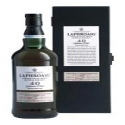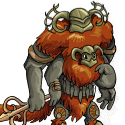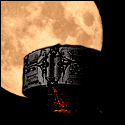|
Inverse Icarus posted:Oh, I have a really dumb question that I haven't really been able to find an answer to: A party is boned if it has nobody who can disable traps or have a reliable Perception score. Consider adding a minor NPC the party can use for those tasks, or a magic item, like a set of Lockpicks that give you the Rogue trapsense and Disable Device skill. If those don't seem like elegant solutions, you could always lower the Perception and Disable Device DCs to an appropriate level.
|
|
|
|

|
| # ? May 17, 2024 14:48 |
|
You get XP from overcoming challenges. Surviving a trap is overcoming it if you then procede to the next room. Think more abstractly and you'll be fine. They get XP from the trap when they avoid it/defeat it/survive it and continue on with the dungeon/adventure.
|
|
|
|
Laphroaig posted:You get XP from overcoming challenges. Surviving a trap is overcoming it if you then procede to the next room. Think more abstractly and you'll be fine. They get XP from the trap when they avoid it/defeat it/survive it and continue on with the dungeon/adventure. So if you open a door and walk into a room, and a giant glaive stabs at your chest and knocks you to negative hitpoints, but you heal up and then move past it, you get XP? Even if the trap resets and hits you again on the way out? Obviously a trap would only award XP once, but can they really just bumble through them and get the rewards for beating them? I could see if they saw the trap and avoided setting it off, but just sending in the Paladin to take the hits seems a little cheesy.
|
|
|
|
Magic Rabbit Hat posted:A party is boned if it has nobody who can disable traps or have a reliable Perception score. Consider adding a minor NPC the party can use for those tasks, or a magic item, like a set of Lockpicks that give you the Rogue trapsense and Disable Device skill. If those don't seem like elegant solutions, you could always lower the Perception and Disable Device DCs to an appropriate level. They already have a Chime of Opening for stubborn doors. I hadn't thought about an item specifically for finding traps. There are two Tengu rogues in the dungeon, who have barricaded themselves inside a room after a monster attacked them. One of them could join the party and help out. Sadly, the Paladin rolled a lovely Diplomacy check and only made them angrier, and then tried (and failed) to kick down the door, which can't help matters. I've added a corpse of a halfling rogue in the dungeon for some flavor and to give them some other items they might need, maybe he'll have some sort of magical thieves' kit. I'm not sure how to get around the whole "the party is loving blind" thing without just lowering the DCs. Especially for the new guys, I'd like to burn in the fact that Perception is a big deal. Maybe I'll lower a bunch of them but leave a few others normal. Looking over their sheets, the Wizard actually doesn't have a terrible Perception with a +7 (+2 WIS, +1 Rank, +2 Gnome, +2 Alertness). Everybody else is at +3 or lower. A lot of the traps are DC 25+ to spot, which is impossible for anyone but the Wizard. I'll look to tuning them down.
|
|
|
|
I would say that you can get the experience from a trap once - and you receive a reduced rate if you set it off unintentionally and survive. However, well-planned trap activations or deactivation would be worth the full amount. So, you get a greater benefit if you deal with a trap "properly" rather than just set them off, but don't be punished overtly if your dice were against you that day. The point I'd keep in mind though is that you get one or the other. If you set off the trap accidentally, you wouldn't get experience from setting it off again. The only way I could see getting "more" experience is by... more precisely, getting "the rest" if you set off the trap and then subsequently disarm it. So you'd get the remaining experience that adds up to the full (or perhaps a little less than full) amount if you had properly caught and disarmed the trap in the first place. That might be a little too convoluted though, which is perfect for tabletop games, I think.
|
|
|
|
Inverse Icarus posted:Oh, I have a really dumb question that I haven't really been able to find an answer to: Giving reduced XP for accidentally activating traps and surviving could work, too, but it really depends on how you're scaling the difficulty of your campaign and how quickly they should be gaining. With those re-arming traps, I'd say to give them the XP once they've gotten to a point that they are obviously never going to stumble upon the trap again -- basically after they've cleared the dungeon (or a certain segment of the dungeon, or that specific room) to the point that they won't need to return to those trapped areas in the campaign. quote:Especially for the new guys, I'd like to burn in the fact that Perception is a big deal. (e: Also, holy poo poo this thread moves fast when someone asks a question.) lesbian baphomet fucked around with this message at 02:24 on Feb 18, 2012 |
|
|
|
One simple way to improve your party's perception is to hand them a headband of vast intelligence +2 keyed to the skill. It'll bring the wearer to full ranks. Unless, of course, no one wants to use it for some reason.
|
|
|
|
|
...
Nostalgia4ColdWar fucked around with this message at 03:25 on Mar 31, 2017 |
|
|
|
For what its worth, you are running a module I take it? Why are there all of these traps around if they don't actually mean anything? If you get hit by a trap and all it does is use up charges on Ye Old Wand of Vigor (or Cure Light Wounds), whats the point of it even being there? You could just ignore these traps entirely, since they are obviously not mattering if the group is sending the Paladin ahead to take a hit and get healed up. They can't even spot the things, so you are playing a game of "Randomly take damage, heal up, move on" with your players. If they were completely engaged with the idea of traps, or you had a rogue character getting a chance to be awesome, or something that makes keeping them there -matter-, then sure keep them. If they are just uninteresting, ditch them or DM teleport in some means for the players to overcome them, be it the ability to spot it via letting them take 10 or 20, or the Wand of Find Traps. I wouldn't even bother with it not being fully charged; just take the cost out of the treasure at the end if it really bugs you. If they can spot the traps, then you can let them come up with some clever ways to get around it since no one has Disarm. If they are not engaged in the idea of traps or wanting to bypass them in a clever way, ditch the traps as a whole since they serve no purpose in terms of either the system or thematics. As far as XP for overcoming challenges: if the players can just ignore a challenge, its not really a challenge now, is it? If the traps are legitimate impediments they need to worry about, then give them experience points, even if their method of trap detection is to send in the Paladin. Frankly, at least your group isn't tunneling their way through the walls to avoid the traps, or poking every square with a 10 foot pole, or having the Paladin remove a door from its frame and walking forward with that to avoid damage, or any of the drat fool things PCs do because they have had a bad trap experience before and "its what you do". Laphroaig fucked around with this message at 05:01 on Feb 18, 2012 |
|
|
|
...
Nostalgia4ColdWar fucked around with this message at 03:26 on Mar 31, 2017 |
|
|
|
I don't get the mentality that forms at the crossroads of "you must get this much XP to level" and "XP only comes from fighting monster and disabling traps". Its not a video game. Just give the players XP, and just level them at the appropriate time. Just last session, we were 99xp from leveling and everyone was tired of being level 1. If I was GMing, I just would have just GM fiat and the explanation of "quest XP". Instead, the GM had us fight a 2 small earth elementals, and then rest immediately afterward. It was immensely unsatisfying and felt incredibly forced. Seriously, just level characters when appropriate and stop worrying about the small stuff.
|
|
|
|
Ulta posted:I don't get the mentality that forms at the crossroads of "you must get this much XP to level" and "XP only comes from fighting monster and disabling traps". Its not a video game. Just give the players XP, and just level them at the appropriate time. This is really a matter of preference. If it were something small like the 99xp you mentioned, I'd just give it to them at the end of a session. However, a lot of my players are used to the "kill moster, get xp" mindset (from MMOs or old school RPGs) and they really enjoy it. While I play fast and loose, I don't just level them when it feels right. I'm also pretty new so I'm not even sure I'd know. Laphroaig posted:For what its worth, you are running a module I take it? Why are there all of these traps around if they don't actually mean anything? If you get hit by a trap and all it does is use up charges on Ye Old Wand of Vigor (or Cure Light Wounds), whats the point of it even being there? It's a module, yes. The problem is that there are a lot of traps. Most of them are flavorful to an extent. If you know anything about Thassalon and Sin magic, each Runelord has a statue here with an associated crypt, where their honored dead are buried. Most of them are trapped with a spell or effect relating to the magic/sin, such as a color spray trap for Pride, and a swinging glaive for Greed (which is Runelord Karzoug's favored weapon). I'd rather not just get rid of them. Some of them aren't even traps, exactly. there's one statue that can give you a buff or a debuff, such as Bless or Flare, for example. It has 6 outcomes, 3 good and 3 bad. The gunslinger touched it twice, and got two bad ones (sickened and dazzled). They left the statue alone after that, never having seen a "good" one. I think just giving one of the characters (probably the Wizard) Trapsense and Disable Device would be the easiest way around this. My players are (mostly) mature, and if I come out and just say "Listen, you don't have a Rogue and it's going to be a problem. I'm giving the Wizard these non-combat powers so you don't get decimated." that they'll be alright with that. It's either that, or contriving a scenario where one of the Tengu Rogues follows them around. I'm reluctant to have a "DM PC" or anything like that, though.
|
|
|
|
Also, thanks to everyone for the advice. I'm still working on how I'm going to handle it, but all of this is very useful.
|
|
|
|
Inverse Icarus posted:This is really a matter of preference. Its usually every two or three sessions. At lower levels keep it quick and snappy, as you tend to have a smaller pool of options and those options tend to be blander. Higher levels can take longer simply because you have more options to use. Also this is dependent on your group. Get to the level range your group likes quickly, (or start there) and slow down then.
|
|
|
|
Ulta posted:Its usually every two or three sessions. At lower levels keep it quick and snappy, as you tend to have a smaller pool of options and those options tend to be blander. Higher levels can take longer simply because you have more options to use. Also this is dependent on your group. Get to the level range your group likes quickly, (or start there) and slow down then. How long are your sessions? How many encounters per session? I know you said you don't crunch the numbers, but ballpark it for me. My players are mostly new, and as such slower. I'd like the leveling will be pretty standard, maybe on the slower side, so they can get used to their abilities and then see the increase of power. Maybe I'm overthinking it and should just let them level quicker. However, I'm currently just using a module, which only runs from levels 1-2. They left some hooks for extrapolation, so I added a small mini-dungeon with my own encounters in it, but overall I don't think they'll hit third level by the time the adventure ends. After this module I'm going to ask the players if any of them want to continue playing their characters. If not, I'll start some other module, or maybe an adventure path. If they do want to continue, I'll try to string this module to another one, starting at level 3. If they're not there yet, I'll just give it to them. Anyone who doesn't like their character is free to roll up a new one at 3rd level for the new module. We'll see how it pans out. Thanks again.
|
|
|
|
Ahh Runelord stuff. You can actually get really good mileage out of Detect Magic and the various Knowledge skills here, since most of the traps are magical in nature and are not under a permanent nondetection or anything. Could the Wizard walk around as a radar with Detect Magic up, and you could have him roll knowledge skills to provide insight on the history of each thing, so 1) you fill in story areas since you feel these traps are important to the history and feel of these places and 2) allow for them to function as the "disarm" check; you provide some insight into the working of the trap such as that a solution to bypass it immediately presents itself on a successful roll, and do not provide such insight if they fail the roll.
|
|
|
|
Awesome idea. The Wizard has lots of Knowledge skills, and has made various rolls already confirming runes around the dungeon, and relating them to the various sins and associated schools. I could just lump Detect Magic in with standard "trap checking" for the group and use the knowledges and maybe Spellcraft. If he fails the checks he'll at least know something is there from detect magic, which is a lot like Trap Spotting and a decent Perception check. And if they can't figure it out and just want to just walk into it, whatever. I can also just pretend most/all of the physical traps (like spears, arrows, etc) have some magical component to them and are detectable this way, even if it's not standard. The majority of traps are in "obvious" places, like entrances to crypts, or touched statues. I'd imagine that after the first trap they hit, they'll be careful around obvious "trappable areas", and I can just say the wizard uses Detect Magic during any searching. I like this idea a lot. It's not heavy-handed or intrusive, and I think it'll have the same desired effect. Thanks.
|
|
|
|
Inverse Icarus posted:How long are your sessions? How many encounters per session? I know you said you don't crunch the numbers, but ballpark it for me. My players are mostly new, and as such slower. I'd like the leveling will be pretty standard, maybe on the slower side, so they can get used to their abilities and then see the increase of power. Maybe I'm overthinking it and should just let them level quicker.
|
|
|
It's often useful to think of leveling in a more meta sense rather than getting bogged down in the details of per-encounter experience. To that end, here are a couple of questions you might think about :
|
|
|
|
|
Another reason to use an "average party level" mechanic and not bother with experience at all is that Pathfinder has, to my knowledge, done completely away with all the finagly little experience point consuming functions. Crafting magic items and casting certain spells no longer requires experience points, and nothing else in the game makes you lose any. Except maybe the Deck of Many Things. I'd have to double-check. Even energy drain doesn't cause level loss anymore, since there's an actual mechanic for negative levels, and they're never truly permanent -- even negative levels designated as permanent can be cured with a Restoration spell.
|
|
|
|
Hey all, I need some feedback on my next house-rule; a combat mechanic that will achieve the following effects: - simplify combat mechanics - buff martial combat - give players more options and flexibility These rules will eliminate a significant number of dice rolls and special-case rules such as: full-attack actions, non-lethal attack actions, existing dual-wield rules, combat maneuvers as a separate individual actions, shield-slam rules, and perhaps a bunch more rules and feats. Summary: Full-attack actions are eliminated and all attacks are grouped into one of three attack actions: Standard Attacks, Slam Attacks, and Tactical Attacks. Each of these attacks is resolved by a single d20 roll and scores a number of effects equal to the number of 4-point magnitudes of success. The effects of the attack are chosen by the attacker after-the-fact, allowing for some flexibility and player-controlled narration of the attack action. Standard Attacks Standard Attacks are taken as a standard action. Standard Attacks are resolved with a single d20 attack roll at BAB against a primary target's AC. Standard Attacks represent a series of offensive moves intended to injure an opponent. On a successful roll, the attacker scores one standard attack effect plus one for each additional four points by which the difficulty is exceeded. The attacker chooses any combination of standard attack effects to apply. The attacker may freely apply standard attack effects to any target within range that had a target attack-roll less than or equal to the primary target. Standard Attack Effects Weapon Damage: per effect, inflict one die of weapon damage plus bonuses. Non-lethal Damage: per effect, inflict 1d3 plus Str non-lethal damage. Bleed Damage: per effect, the target gains 1 point of bleed status effect. May only be used when attacking with a weapon that can slash or pierce. Critical Hits Critical hits do not multiply damage. Critical hits add one extra standard effect for every number by which the multiplier exceeds 1 (2x gives one extra effect, 3x gives two extra effects, etc.). Dual-wielding A dual wielder is required to spend at least one of their weapon effects beyond the first on weapon damage from the off-hand weapon. Without feats, dual-wielding is just an non-penalized flavor option. The two-weapon fighting feat is changed to simply give a +2 bonus to Standard Attacks when fighting with a light weapon in the off-hand. This effectively increases the likelihood of scoring multiple combat effects (roughly one extra effect every other action) at the expense of requiring one of the extra effects to be from the off-hand weapon. A shield wielded as a second weapon (shield bash) is treated in the same way (+2 attack bonus if foregoing a light shield's armor bonus to use it offensively for the round, the shield must be used for one damage effect beyond the first). Slam Attacks Slam Attacks are taken as a standard action that provokes an attack of opportunity. Slam Attacks are resolved with a single d20 attack roll using BAB against a target's touch-AC. Weapon bonuses (enhancements, feat bonuses, etc) are not normally included in a slam attack. Slam Attacks represent a physical assault that aims to overpower a target than bypass their defenses. On a successful roll, the attacker scores one slam effect, plus one for every four points by which the target difficulty is exceeded. The attacker may choose any combination of slam effects to apply to the target. All slam effects must be applied to the target of the attack. The cost of slam effects are doubled for every size category by which the target exceeds the attacker. The effect of slam effects is doubled for every size category by which the attacker exceeds the target. Slam Effects Push-Back: per effect, the target is pushed in the opposite direction from the attacker by 5 feet, the attacker may follow up to their remaining movement allowance. If the opposite square is occupied, the attacker must spend enough effects to push them back 5-feet as well. Any number of targets in a line may be pushed back in this way given enough slam-effects to move them all. Knock-Back: per two-effects, the target is sent flying back 5 feet and must make an acrobatics check as if falling one level (taking damage and falling prone on failure). If the Slam Damage: one effect (one effect maximum), deal 1d3+Str points of non-lethal damage. Shaken: one effect, the target is shaken for the next round. Staggered: two effects, the target is staggered for the next round. Prone: four effects, the target is knocked prone. Slam Criticals Slam attacks score a critical hit on a natural 20. A slam critical adds one extra slam effect. Shield Slam Feat The Shield Slam feat gives a +2 weapon bonus to slam attacks when a shield is used. Blunt Weapon Feats When attacking with a blunt weapon that a character has Weapon Focus in, the character may apply any weapon-specific to-hit bonuses to their slam attack (including enhancement bonus, weapon focus, weapon expertise, etc.) When attacking with a blunt weapon that a character has Weapon Specialization in, the character may deal normal lethal weapon damage when selecting the Slam Damage slam effect. Tactical Attacks Tactical Attacks are taken as a standard action. Tactical attacks are resolved as a single d20 attack roll using CMB against a target's CMD. Tactical Attacks represent a measured style of fighting intended to put an opponent at a disadvantage rather than to injure them. On a successful roll, the attacker scores on tactical effect plus one for every four points by which the target difficulty is exceeded. The attacker may choose any combination of tactical effects to apply to the target. All tactical effects must be applied to the target of the attack. Tactical effects provoke attacks of opportunity when applied if appropriate, with feats eliminating these attacks of opportunity as normal. The cost of some tactical effects doubles for every size category by which the target exceeds the attacker. Tactical Effects Tactical effects are generally the same as combat maneuvers, however these mechanics allow for multiple combat maneuver effects to be applied in one attack roll. Trip: AoO. one effect (double per size), the target is tripped prone. The cost of this effect increases by one for every additional pair of legs on the target. Dirty Trick: AoO. per effect, apply a status effect to the target. Disarm: AoO. per effect (double per size), the target drops one item held in-hand. Sunder: AoO. per effect (double per size), sunder's the target's weapon. Drag: per effect (double per size), the attacker and target move 5ft. Normal drag rules apply. Reposition: AoO. per effect (double per size), the target is moved 5ft. Normal reposition rules apply. Steal: AoO. per effect, take one item from the target which is readily available and not fastened. Stealing items that are fastened to the target costs and additional effect. Grapple: AoO. one effect (double per size), the target is grappled. Grapple-Damage: per effect, if the target is grappled, apply grapple damage as normal. Grapple-Move: per effect (double per size), if the target is grappled, move the grapplers as normal. Pin: one effect (double per size), if the target is grappled they are now pinned. Tie-Up: one effect, if the target is pinned and the attacker has rope available, the target is now tied-up. Discussion The rules greatly simplify martial combat by reducing full attacks to a single die-roll that is roughly mathematically equivalent to making multiple rolls. To think of it intuitively, it is like rolling the die once and applying that result to all of the attack rolls in a full-attack, then choosing the targets after-the-fact. It also is a simplification in that dual-wielding is reduced to a simple to-hit bonus that effectively increases the likelihood of scoring an extra attack. The rules give a buff to martial combat by giving the effects of a full-attack in a standard action, allowing both mobility and high damage output during combat. It is also a buff in that it allows low-level characters that would not otherwise have multiple attack to score multiple hits on high attack rolls. The magnitude-of-success interval of 4 is roughly a 20% buff to martial combat because existing full-attack mechanics effectively use 5 as the magnitude difference between attack bonuses in a full-attack. These rules give the player flexibility by allowing the player to choose from a combination of effects after the roll. This allows for high attack-bonus characters to perform dramatic attacks and combinations in one action that would otherwise take multiple actions, such as grappling, pinning and hog-tieing a target in one fell swoop, or would be impossible, such as sending an enemy flying 30 feet backwards through the air. Open Questions These rules are fairly well fleshed out, however there are some details left to figure out. Some open questions that remain: - I have chosen 4-point magnitude increments as a slight combat buff, would 5-point magnitude increment be more appropriate as it more closely matches the original attack bonus increments? - Two-weapon fighting: I like changing un-feated two-weapon fighting to a simple flavor variant, but is the +2 bonus (averages to an extra half-attack) appropriate for feated two-weapon fighting? Should it be +2 for two-weapon fighting feat and +4 for two-weapon fighting feat with a light off-hand weapon? (average to one extra attack) - Speaking of multiple attacks, how should these rules affect monsters and animals with multiple natural attacks? If the intent is to reduce all attack rolls to a simple single roll, then this could potentially simplify all attack rolls, including for monsters. It could be changed to something like a monster gets +2 to-hit (average +0.5 effects) for each additional primary attack and +1 to hit (average +0.25 effects) for each additional secondary attack, and must choose some combination of different natural attacks as effects. - Should criticals be confirmed or just automatically add extra effects? This would continue to streamline by eliminating the extra confirmation roll, as well as be a combat buff. - How should the idea of multiple-attack-effects-per-roll interact with Attacks of Opportunity? should an AoO be allowed to score multiple effects? Should any of the three attacks be allowed for AoOs? It could allow for some cool effects, such as using an AoO to slam an agressor out of a charge by disrupting straigt-line movement. - How should the idea of multiple-attack-effects-per-roll be combined with existing combat feats such as Cleave, Great Cleave, Viper Strike, etc? On one hand, stacking the benefits could be a tremendous melee combat buff (perhaps too much), but on the other hand the new mechanic allows such flexibility and mobility that combat could be further streamlined by eliminating a slew of extraneous feats. - For variety, I am toying with the idea of letting players choose one combat effect of another effect type to flavor their high success rolls (e.g. blunt weapons doing weapon damage effects in slam attacks), however each attack type has a very different difficulty (slams tend to be easy, standard attacks more difficult, and tactical attacks most difficult), and I want to preserve the idea that each attack type has a different intent and slam is specifically easier because it is not intended to do damage (and causing slam status effects is expensive). Should these cross-type effects be allowed and if so how should they be implemented? Should it be automatically selectable for more flexibility out of the gate, based on existing feats (e.g. improved disarm allows for disarm effects during standard attacks), or based on new feats (e.g. Tactical Feat X allows one tactical effect during a standard attack)? - The idea of non-linear success scale has come up as a way of buffing martial classes. The idea being that instead of a straight one-effect-per-magnitude (a 1,2,3,4,5,6... progression for every 4-point magnitude) the attacker gets to choose a number effects based on a non-linear schedule (I am liking a Fibbonacci progression such as: 1,2,3,5,8,13...). This could get out of hand for fighters with high attack bonuses. For instance, a slam attack versus an Adult Red Dragon touch-AC 8, from a level 20 fighter (+20 BAB, +5 str) would likely score eight magnitudes of success, (8 effects on a linear scale, allowing a knock-back of a huge creature by 5ft) or 34 effects on a Fibbonacci scale, enabling the fighter to perform a knock-back slam attack (costing 8 effects per increment for a Huge creature) sending the dragon flying 20ft. With a specialized and enhanced blunt weapon and allowing weapon bonuses on slam attacks (+5 wpn spec, +2 wpn foc, +5 enhance) the same fighter could expect ten magnitudes of success, or 89 effects, playing Dragon-Baseball for a 55-foot swat. I am sure there are more concerns resulting from these changes that I have not considered. Any and all feedback is appreciated!
|
|
|
|
Regarding the flexibility options, I think it might be reasonable to allow effects from easier attack forms to be freely applied to other attacks - i.e. standard attacks may freely use slam effects, and tactical attacks may freely use slam and standard effects. This seems a reasonable compromise, but does the assumption that CMD is higher than AC always hold?
|
|
|
|
I think allowing hero points to add arbitrary effects to successful attacks would also be a fun option. This could allow creative players to do Rambo-combos such as the knocking an enemy into the air with a slam and then using a hero point to quickdraw a bow and shoot the enemy with an explosive arrow mid-flight.
|
|
|
|
That rule is going to get really funny the first time a wizard casts True Strike.
|
|
|
|
I don't really think your system does anything to simplify things. It has multiple subsections and options, all of which are a new system a player would have to master and adapt to. Plus you are talking about loving fibonacci sequences and I don't even have a clue what that means. It does not address the linear fighter/quadratic Wizard problem. Thus, buffing melee only means that melee becomes a slightly more attractive option for the casters who go into melee range (clerics, druids, favored souls etc). Basically its just a really complicated mess and I understand what you are trying to do, but you need to step back and re-evaluate the concept of simplicity, as well as how you can give the bottom tier classes like Fighter save-or-dies and save-or-lose to help them at least keep up with the Wizard. Edit: Oh yeah, and monsters with insanely high to-hit bonuses are going to push player's poo poo in. A Red Dragon casting true strike and making a standard attack is going to one-shot most players. I really like the idea of a Dragon taking out rope and using its massive to-hit to ensure the full tactical line of proning, pinning down, and tying up a character on a single roll. It makes me laugh, because it is comical, and it is completely allowed using your system. Laphroaig fucked around with this message at 03:06 on Feb 19, 2012 |
|
|
|
Provoking OAs makes Slam Attacks really terrible.Paolomania posted:This could get out of hand for fighters with high attack bonuses. For instance, a slam attack versus an Adult Red Dragon touch-AC 8, from a level 20 fighter (+20 BAB, +5 str) would likely score eight magnitudes of success, (8 effects on a linear scale, allowing a knock-back of a huge creature by 5ft) or 34 effects on a Fibbonacci scale, enabling the fighter to perform a knock-back slam attack (costing 8 effects per increment for a Huge creature) sending the dragon flying 20ft. With a specialized and enhanced blunt weapon and allowing weapon bonuses on slam attacks (+5 wpn spec, +2 wpn foc, +5 enhance) the same fighter could expect ten magnitudes of success, or 89 effects, playing Dragon-Baseball for a 55-foot swat. J. Alfred Prufrock fucked around with this message at 03:38 on Feb 19, 2012 |
|
|
|
Ferrinus posted:That rule is going to get really funny the first time a wizard casts True Strike. This is a very good point. I'd probably have to mod that spell to basically "score an automatic attack effect as a standard action".
|
|
|
|
Encouraging a dragon to melee rather than cast spells is kinda cool though, at least, and I can see the idea there of adding status type effects to a Fighter lets them do the save-or-lose type situation that they really are incapable of doing but, yeah, it also just makes Clerics just better? Possibly you could make the process very feat intensive? A 20th level Fighter pushing a Dragon 50ft if that is what his character is fully focused on doing is underpowered, not overpowered. Remember the alternative here is that the Dragon rolls a small number and literally dies to the caster.
|
|
|
|
Laphroaig posted:I don't really think your system does anything to simplify things. quote:It has multiple subsections and options, all of which are a new system a player would have to master and adapt to. quote:Plus you are talking about loving fibonacci sequences and I don't even have a clue what that means. quote:It does not address the linear fighter/quadratic Wizard problem. Thus, buffing melee only means that melee becomes a slightly more attractive option for the casters who go into melee range (clerics, druids, favored souls etc). quote:Basically its just a really complicated mess and I understand what you are trying to do, but you need to step back and re-evaluate the concept of simplicity, as well as how you can give the bottom tier classes like Fighter save-or-dies and save-or-lose to help them at least keep up with the Wizard. quote:Edit: Oh yeah, and monsters with insanely high to-hit bonuses are going to push player's poo poo in. A Red Dragon casting true strike and making a standard attack is going to one-shot most players. quote:I really like the idea of a Dragon taking out rope and using its massive to-hit to ensure the full tactical line of proning, pinning down, and tying up a character on a single roll. It makes me laugh, because it is comical, and it is completely allowed using your system.
|
|
|
|
J. Alfred Prufrock posted:Provoking OAs makes Slam Attacks really terrible. quote:Also if you consider a 20th-level fighter pushing a dragon "out of hand" then I don't think you really understand the fighter/wizard problem.
|
|
|
|
Karandras posted:Encouraging a dragon to melee rather than cast spells is kinda cool though, at least, and I can see the idea there of adding status type effects to a Fighter lets them do the save-or-lose type situation that they really are incapable of doing but, yeah, it also just makes Clerics just better? Yeah, I also like the idea of a dragon being able to grab a medium creature in claw and pin them to the ground in one fell swoop. The big problem is that these rules effectively turn to-hit bonuses into attack multipliers (potentially non-linear if that gets added in). This works for classes who gain attacks based on BAB, however monsters' attack bonuses are not balanced around this mechanic. I think to put monsters on this mechanic would require a rebalancing of each monster, which is too much work for something that I was hoping to use as a drop-in replacement rule. As for clerics, they should lag behind a fighter's attack bonus both through BAB as well as weapon specialization bonus and other feats, so I'm fairly certain the fighter's expected roll will stay at least one magnitude of success ahead of them, probably more at higher levels. Again, I agree that SoD/SoLs are problems, but that is not what this particular house rule is meant to address.
|
|
|
|
Paolomania posted:But my slam attacks as written do not provoke attacks of opportunity? Paolomania posted:Slam Attacks Clerics fall behind in terms of Feats and raw BAB but they pull ahead due to self-buffs. I know you're not trying to address that problem of save-or-lose but you're going through a re-write of the combat system that doesn't really address what the biggest problem with combat is. If you're going to all this effort you should add in something that makes rolling to hit against AC a good idea at all levels in the game. I do like the idea and the single roll is a lot better than iterative attacks. I think it'll improve your games for sure and make melee more interesting but I don't think it fixes any problem that Pathfinder really had. Karandras fucked around with this message at 05:45 on Feb 19, 2012 |
|
|
|
Yarrr. Right. Would probably have to feat that away like the other pathfinder combat maneuvers. Improved bull rush could probably serve this purpose since that is effectively rolled into slam attacks anyhow. And that actually makes some sense too to make a slam attack something more easily done by someone taking combat feats.
|
|
|
|
To solve the class sorta issues I'd make it relatively feat intensive (Whilst being all Fighter bonus feats) and stick in some more crippling status type things. Being able to stun, knock unconscious or other actually fight ending things should be the goal for a change like this, I'd think. Feat to not provoke AOO is a good idea, yeah.
|
|
|
|
I was initially considering making some of the effects for each attack require feats, so for instance to get the bleed effect you would require weapon focus or something. I wrote it up this way to give players a lot of flexibility, but this could be changed. Perhaps a few basic effects could be available to all, with the really damaging status effects left to fighter feats.
|
|
|
|
Tiny (and smaller) creatures have 0 reach and have to enter your space to attack you. Do they provoke normally when they move through your threatened square into your square?
|
|
|
|
Inverse Icarus posted:Tiny (and smaller) creatures have 0 reach and have to enter your space to attack you. Do they provoke normally when they move through your threatened square into your square? That would make sense in the same way that a 10 foot reach weapon threatens someone approaching when they are both two squares and one square away.
|
|
|
Inverse Icarus posted:Tiny (and smaller) creatures have 0 reach and have to enter your space to attack you. Do they provoke normally when they move through your threatened square into your square? When a Tiny or smaller creature in a square adjacent to a creature that threatens adjacent squares (e.g. a Medium creature armed with a non-reach melee weapon) leaves that square to enter the threatening creature's space, it provokes. This is simply an application of the usual rule that leaving a threatened square provokes.
|
|
|
|
|
I've been thinking on the monster issue with my house-rule overnight and it occurs to me that a simple way to make it more equivalent to the existing system is to just put a cap on the number of effects that a monster can use - essentially the number of natural attacks that it has. Such a cap could also apply based on class levels or whatnot, so it remains low for casting classes (something like 3) but grows much higher for martial classes. This would also solve the True Strike problem without changing the spell. This cap could either be on the maximum number of effects, but to make it work better if a non-linear effect schedule is used, I think it could instead be a limit on the number of magnitudes of success. I.e. each race gets a natural limit on magnitude of success on attack rolls (3 for humanoids) and every X levels taken in Fighter/Barbarian increases the maximum magnitude of success by one. Although this introduces a new statistic (max attack effects), I still argue that it is a simplification because it removes more statistics (multiple secondary attack bonuses). Paolomania fucked around with this message at 17:30 on Feb 19, 2012 |
|
|
|

|
| # ? May 17, 2024 14:48 |
|
Another thing that I am considering is the limitation on slams and tactics that they must all be applied to the same target, rather than any target that is as easy or easier to hit than the primary target. I'm not sure what my original intent with this limitation was. Without it you can get cool scenes involving surrounding enemies such as a high level kung-fu master tripping them all, or a duelist disarming them all, or a raging hulk sending them all flying.
|
|
|















